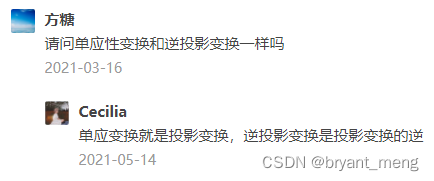-
【Homography Estimation】《Deep Image Homography Estimation》

arXiv-2016
1 Background and Motivation
用卷积直接回归单应性矩阵(transformation estimation,homography estimation),8个自由度
The homography is an essential part of monocular SLAM systems in scenarios such as:
- Rotation only movements
- Planar scenes
- Scenes in which objects are very far from the viewer
2 Related Work
无
3 Advantages / Contributions
利用卷积神经网络学四个点的偏移来进行 Homography Estimation
4 Method
1)The 4-point homography parameterization

单应性矩阵把图 ( u , v ) (u,v) (u,v) 映射成了 ( u ′ , v ′ ) (u',v') (u′,v′)H11 H12 H21 H22 与旋转有关,H13 H23 和平移有关
Balancing the rotational and translational terms as part of an optimization problem is difficult
单应性矩阵中 9个参数相互组合有实际意义,没有完全解耦干净, 9 个参数共 8 个自由度,作者直接改学图 ( u , v ) (u,v) (u,v) 映射成了 ( u ′ , v ′ ) (u',v') (u′,v′) 的 4 个坐标的偏移(传统方法也有这么干的)

学到 4 个坐标的偏移后,利用 OpenCV. 的
getPerspectiveTransform()方法就可以计算出单应性矩阵了输入来自源图像的 4 个点和加上偏移的 4 个新点,
getPerspectiveTransform将返回一个(3,3) 矩阵2)Data Generation for Homography Estimation
applying random projective transformations to a large dataset(MS COCO)


原图上随机选个矩形区域 p,四个顶点随机偏移,根据四个点前后坐标,计算出单应性矩阵,然后把单应性矩阵作用到原图生成新的图,新的图对应的 p 区域 p’ 和 原图的 p 联合送入网络学习原图四个顶点坐标的偏移(step2)进而求出 H A B H^{AB} HABimport cv2 import numpy as np im1 = cv2.imread('left.jpg') im2 = cv2.imread('right.jpg') src_points = np.array([[581, 297], [1053, 173], [1041, 895], [558, 827]]) dst_points = np.array([[571, 257], [963, 333], [965, 801], [557, 827]]) H, _ = cv2.findHomography(src_points, dst_points) h, w = im2.shape[:2] im2_warp = cv2.warpPerspective(im2, H, (w, h))- 1
- 2
- 3
- 4
- 5
- 6
- 7
- 8
- 9
- 10
- 11
- 12
- 13
- 14
Managing the training image generation pipeline gives us full control over the kinds of visual effects we want to model
比如加模糊(robust to motion blur),加遮挡(robust to occlusions)
3)ConvNet Models


VGG-style
输入两个单通道 concat, 128 ∗ 128 ∗ 2 128*128*2 128∗128∗2
( I A , I B , H A B ) (I_A,I_B,H^{AB}) (IA,IB,HAB) from real images, seemingly infinite dataset
回归网络 the real-valued homography parameters,只有输出结果,无法反应置信度
分类网络 a distribution over quantized homographies and can be used to determine the confidence of an estimated homography


把偏移量化输出到 21 个空间(盲猜一手 5x5 去掉 4 个顶点,25-4 = 21)When evaluating the Classification HomographyNet, the corner displacement with the highest confidence is chosen.
5 Experiments
5.1 Datasets
warped MS-COCO images(resized to 320x240 and converted to grayscale)
训练集
产生 500,000 pairs 数据,patch 大小 128x128(蓝色实框区域),随机偏移的范围 ρ \rho ρ 设置为了 32(虚线黄色框范围)

测试集5000,resize 成 640x480,patch 大小为 256x256 区域(主要是方便对比传统方法,作者对比的传统方法中 patch 的区域为 128x128 的话难找到特征点)

评价指标,预测出的4 个坐标 和 GT 的均方差
5.2 Experiments

回归的好


6 Conclusion
作者 We hope that more geometric problems in vision will be tackled using learning paradigms.
节选一些优秀的博文
单应性矩阵 H

单应性原理被广泛应用于图像配准,全景拼接,机器人定位SLAM,AR增强现实等领域



刚体变换:平移+旋转,只改变物体位置,不改变物体形状
仿射变换:改变物体位置和形状,但是保持“平直性”(原来平行的边依然平行)
投影变换:彻底改变物体位置和形状
为啥 3x3 矩阵只有 8 个自由度???(单应性Homograph估计:从传统算法到深度学习)

3)仿射变换和单应矩阵有什么本质的区别?





-
相关阅读:
width:100%和width:auto有啥区别
含文档+PPT+源码等]精品基于NET实现的旅游景点推荐系统[包运行成功]计算机毕业设计NET毕业设计项目源码
CompletableFuture
php deployer 从入门到精通
猫罐头哪种好吃又健康?精选5款营养美味的猫罐头推荐!
9个Excel小技巧,提高你的数据分析效率
Java / Tensorflow - API 调用 pb 模型使用 GPU 推理
形参与实参
计算机组成原理学习笔记(持续学习中)
【教学类-12-03】20221106《连连看横版8*4(2套题目 适合中班))(中班主题《我们的城市》)
- 原文地址:https://blog.csdn.net/bryant_meng/article/details/125811906
